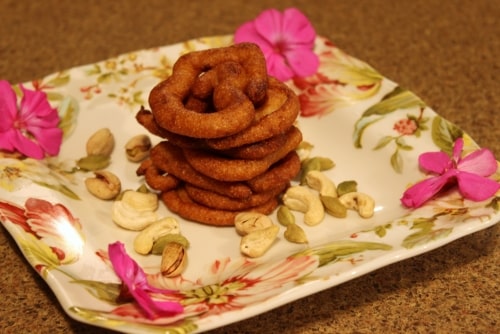Singhal: Sweet Beginnings, Happy Endings! – Chef Curry Do’pyaza’s Rasoi
Namaste Dosto! Kem Cho? (Hello Friends! How are you?) Chef Curry Do’pyaza here, ready to tickle your taste buds with a truly delightful sweet treat: Singhal!
This golden, crispy delight is a staple in many Gujarati households, especially during Diwali, Janmashtami and other joyous occasions. It’s a sweet way to celebrate good times with family and friends. Think of it as a warm hug on a plate, a sweet memory waiting to be made.
A Little History Lesson (Don’t worry, it’s tasty!)
Singhal isn’t some newfangled invention. It’s been around for generations! Passed down through grandmothers and mothers, each family has their own special twist. The core idea is simple: a sweet, deep-fried delight made from semolina. But the magic is in the details, the spices, and the love that goes into making it.
The Recipe Deets
- Preparation Time: 15 minutes
- Cooking Time: 20 minutes
Ingredients List:
- Sooji (Semolina): 1 cup
- Ghee (Clarified Butter): 1/4 cup + for frying
- Doodh (Milk): 1/2 cup
- Cheeni (Sugar): 1/2 cup
- Elaichi Powder (Cardamom Powder): 1/4 teaspoon
- Kesar (Saffron strands): A few strands (optional, for that beautiful golden hue)
- Badam (Almonds): Chopped, for garnish (optional)
- Pista (Pistachios): Chopped, for garnish (optional)
Let’s Get Cooking! (Simple Steps to Sweet Success)
- Roasting the Sooji: In a heavy-bottomed pan, gently melt 1/4 cup of ghee. Add the sooji and roast it on low heat until it turns a light golden brown and releases a nutty aroma. This is crucial! Don’t burn it. We want a beautiful, fragrant base. This takes about 5-7 minutes.
- Sweetening the Deal: In a separate saucepan, combine the milk and sugar. Heat until the sugar dissolves completely. Add the saffron strands (if using) to infuse the milk with a lovely color and flavor.
- Combining the Goodness: Slowly pour the warm milk mixture into the roasted sooji, stirring continuously to avoid lumps. The mixture will thicken quickly.
- Adding the Aroma: Stir in the cardamom powder. This adds a beautiful fragrance and that classic Indian touch.
- Shaping the Magic: Let the mixture cool slightly until it’s easy to handle. Divide the mixture into small, equal-sized portions. Shape each portion into a small, flattened disc.
- Frying to Perfection: Heat ghee in a deep pan or kadhai over medium heat. Gently slide the singhal into the hot ghee, a few at a time. Fry until they are golden brown and crispy on both sides.
- Garnishing and Serving: Remove the singhal from the ghee and drain on a paper towel. Garnish with chopped almonds and pistachios (if using). Serve warm or at room temperature.
Chef’s Tips for Singhal Success
- Low and Slow: Roasting the sooji on low heat is key to preventing burning and achieving that perfect nutty flavor.
- No Lumps Allowed: Stir continuously while adding the milk mixture to avoid lumps.
- Not too Hot, Not too Cold: Make sure the ghee is not too hot while frying, or the singhal will burn on the outside and remain uncooked inside.
- Fresh is Best: Use fresh ghee and good quality sooji for the best results.
Cooking Options for the Modern Cook
- Gas Stove: Follow the recipe as described above.
- Induction Stove: Adjust the heat settings accordingly.
- Air Fryer: You can also air fry the singhal! Preheat your air fryer to 350°F (175°C). Brush the singhal with a little ghee and air fry for 8-10 minutes, flipping halfway through, until golden brown.
- Oven: Preheat oven to 350°F (175°C). Place singhal on a baking sheet lined with parchment paper. Bake for 10-12 minutes, flipping halfway through, until golden brown.
Nutritional Information (Approximate, per serving)
- Calories: 150-200
- Fat: 8-12g
- Carbohydrates: 20-25g
- Protein: 2-3g
Note: Nutritional information may vary based on specific ingredients and portion sizes.
Serving Suggestions
- Serve warm as a dessert after a delicious Indian meal.
- Enjoy with a cup of chai or coffee.
- Pack them in a pretty box and gift them to friends and family during festivals.
Your Turn!
So there you have it, folks! A simple yet incredibly satisfying recipe for Singhal. Now, go forth and create some sweet memories in your kitchen. This recipe is a delightful way to connect with your roots and share a taste of India with your loved ones.
Try this recipe at home and share the joy with your friends and family. I am sure they will love it!
Happy Cooking!
– Chef Curry Do’pyaza
